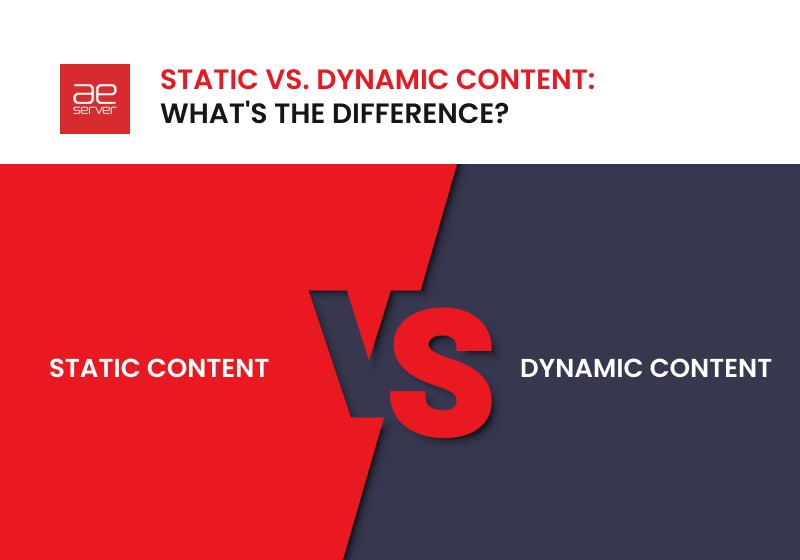Nowadays, the significance of static vs. dynamic content has risen to the forefront. It profoundly influences online experiences. In this digital era, we encounter two fundamental categories of content – Static and dynamic websites. Each category fulfills distinct roles, presenting a unique array of advantages and disadvantages. A comprehensive understanding of these differences is imperative for informed decision-making. It enables us to choose the approach that aligns most effectively with specific needs:


Remember, the decision between static and dynamic content hinges on the unique demands and objectives of your particular project. Therefore, it’s often advantageous to blend both approaches harmoniously. This allows you to attain precise functionality and user engagement. Which aligns with your project’s distinct requirements and enhances the overall user experience.
- Static Content: Static content encompasses fixed, unchanging web elements. These include HTML files and images, serving as the foundation of countless websites. Static content is straightforward to create and deploy, providing exceptional speed and reliability. However, it lacks interactivity. Which makes it less suitable for complex web applications or sites requiring frequent updates.
- Dynamic Content: Dynamic content adapts and evolves in response to user interactions or data inputs. Examples include social media feeds, e-commerce platforms, and content management systems. Dynamic content offers enhanced interactivity and personalization. However, it can be resource-intensive, potentially impacting site performance.
Table of Contents
What is static content?
Static content refers to web pages or elements that remain unaltered unless intentionally modified by a developer. It maintains its original form, devoid of real-time updates or user interactions. This exploration delves into its distinctive attributes. It provides illustrative examples and discusses crucial considerations. The benefits of static content go beyond its simplicity. It offers lightning-fast speed, unwavering reliability, seamless scalability, heightened security, and cost-effectiveness. These attributes make it a compelling choice for various online ventures. In the ever-changing web landscape, simplicity is the path to success. So, what is static content? It is a reliable digital leader that provides stability and performance. Its immutable nature ensures a stable user experience and reduces vulnerability to security threats. In addition, its effectiveness leads to cost savings. This makes it an invaluable asset for web developers and businesses alike. In summary, the enduring qualities of static content make it a reliable cornerstone where speed, security, and simplicity reign supreme.
Advantages and Disadvantages of Static Content
Here is a compilation of the benefits and drawbacks associated with static content.| Advantages of Static Content | Disadvantages of Static Content |
| 1. Optimal Speed and Performance. | 1. Limited Interactivity. |
| 2. Unwavering Reliability. | 2. Content Updates. |
| 3. Seamless Scalability. | 3. Personalization. |
| 4. Enhanced Security Posture. | 4. E-commerce Limitations. |
| 5. Budget-Friendly Operations. | 5. Limited Dynamic Content. |
Static content examples
Static websites are a fundamental component of the online landscape. Particularly for small businesses looking to showcase their products or services. These brochure websites serve as digital business cards. They are offering consistent and unchanging information to visitors. The content remains static, ensuring that users receive the same information every time they explore the site. Blogs, too, come in static variants. Unlike dynamic blogs that require frequent updates. Static blogs house articles that stand the test of time. For example, historical event posts remain unchanged, providing a reliable source of information over the long term. E-books represent another form of static content. Once published, the text and images within an e-book remain fixed unless an updated version is released. This permanence ensures that readers can refer back to the original content without fear of alterations. In a dynamic digital world, these static content formats offer stability, consistency, and reliability to both businesses and readers alike. Learn more about Difference Between Static and Dynamic WebsitesWhat is dynamic content?
Unlike static content, dynamic content possesses a fluid and adaptable nature. It readily responds to user interactions and adjusts based on various factors. Such as user preferences, location, and time. It’s akin to witnessing a living organism evolve in response to its ever-changing surroundings. What is dynamic content? Dynamic content brings forth a plethora of advantages. Including the ability to personalize the user experience and provide real-time updates. It ultimately enhances user engagement and relevance. However, it also brings along its own set of challenges. Its inherent complexity can lead to performance issues, such as potential security vulnerabilities and the risk of escalating costs. Effective utilization of dynamic content necessitates meticulous planning and implementation to strike a balance between mitigating these drawbacks and maximizing its benefits. Personalization is a hallmark of dynamic content. It tailors the user experience to foster deeper engagement. Real-time updates ensure that users are constantly provided with the latest information.
Advantages and Disadvantages of Dynamic Content
Here is a compilation of the benefits and drawbacks associated with dynamic content:| Advantages of Dynamic Content | Disadvantages of Dynamic Content |
| 1. Personalization | 1. Complexity |
| 2. Real-time Updates | 2. Performance Issues |
| 3. Efficiency | 3. Security Risks |
| 4. Interactive User Experience | 4. Compatibility |
| 5. Easier Content Management | 5. Costs |
| 6. Targeted Marketing – Dynamic URLs. | 6. SEO Challenges |
Dynamic content examples
Dynamic content examples are prevalent in various aspects of our digital lives. Offering real-time information and tailored experiences. Here are three prominent examples: 1. Social Media Feeds:- Social media platforms like Facebook, Twitter, and Instagram. Employ dynamic content in their feeds.
- These feeds constantly update in real time, displaying the latest posts from your friends and the accounts you follow.
- This ensures users stay connected and informed with the most recent updates from their social circles.
- Online stores utilize dynamic product listings to enhance the shopping experience.
- These listings change based on user behavior, including search queries, past purchases, and recommendations.
- By adapting the content. Users are presented with products that are more relevant to their interests and needs. It increases the likelihood of making a purchase.
- Weather applications provide real-time weather information, such as temperature, humidity, and forecasts.
- The content within these apps constantly updates as weather conditions evolve. It ensures users receive accurate and timely information to plan their activities accordingly.
- In a rapidly changing digital landscape, dynamic content plays a pivotal role. It keeps us informed, engaged, and satisfied. All by delivering personalized experiences tailored to our interests and needs.
When to Choose Each
| Factor | Static Content | Dynamic Content |
| Performance and Speed | Loads faster due to pre-generation and caching | Content can update in real-time |
| Low Complexity | Ideal for rarely changing information | Suitable for frequently changing content |
| Security | Less susceptible to certain vulnerabilities | May require more robust security measures |
| Cost-Efficiency | Hosting is often cheaper | May require more server resources and costs |
| SEO | Can be optimized for search engines | Requires SEO efforts for frequent updates |
| Real-Time Updates | Not suitable for real-time content updates | Essential for real-time content |
| User Interaction | Limited user interaction capabilities | Allows user interactions (forms, comments) |
| Customization | Limited personalization capabilities | Enables personalization based on user behavior |
| Database Integration | Not reliant on databases | Often depends on databases for data retrieval |
| Scalability | Scales well for low to moderate traffic | Scalable for platforms with variable loads |
When to Choose Static Content
1. Stable Information. If you have information that doesn’t change frequently, like your company’s history or a comprehensive guide. Static content is suitable. It’s efficient and cost-effective for maintaining such content. 2. Budget Constraints. Static websites are generally more budget-friendly to set up and maintain. They require less development effort and server resources compared to dynamic sites. 3. SEO Benefits. Search engines can easily index static content since it remains constant. Static pages can be advantageous if you want to optimize your content for search engines.When to Choose Dynamic Content
1. Personalization. Dynamic content excels at providing personalized experiences. Dynamic content is the way to go if you want your website or app to offer tailored recommendations or user-specific information. 2. Real-time Updates. Perfect if your content relies on real-time data or information that frequently changes. E.g., news websites, social media, or stock market updates. Dynamic content is essential to keep your audience informed. 3. Engagement and Interaction. Dynamic content fosters user engagement. Features like comments, interactive quizzes, and live chats are powered by dynamic elements, enhancing the user experience.Conclusion
In the ever-evolving digital landscape, both static vs. dynamic content have their roles to play. The choice between them depends on your content’s nature. Your objectives and your audience’s expectations. Static content is ideal for stable information, budget constraints, and SEO optimization. Dynamic content excels in personalization, real-time updates, and user engagement. As you embark on your content creation journey, consider these fundamental differences. Also, choose the approach that best aligns with your goals. Remember that in the dynamic world of digital content, the line between static vs. dynamic content can sometimes blur. A hybrid approach may offer the best of both worlds.FAQ
Can a website have both static and dynamic content?
Yes, many websites combine both static and dynamic elements. For example, a blog may have static pages (like the homepage) and dynamic content (like blog posts).
Which is better for SEO, static or dynamic content?
Both can be optimized for SEO. Static content may load faster. However, dynamic content can provide more up-to-date and engaging information. SEO success depends on various factors beyond content type.
What technologies are used to create dynamic content?
Common technologies for dynamic content include server-side scripting languages. Like PHP, Python, Ruby, and JavaScript frameworks like React, Angular, or Vue.js.
Can I convert static content into dynamic content or vice versa?
Yes, it’s possible to convert content types. But it may require significant development work. Consult with a web developer or development team to determine the feasibility and the scope of such a change.





